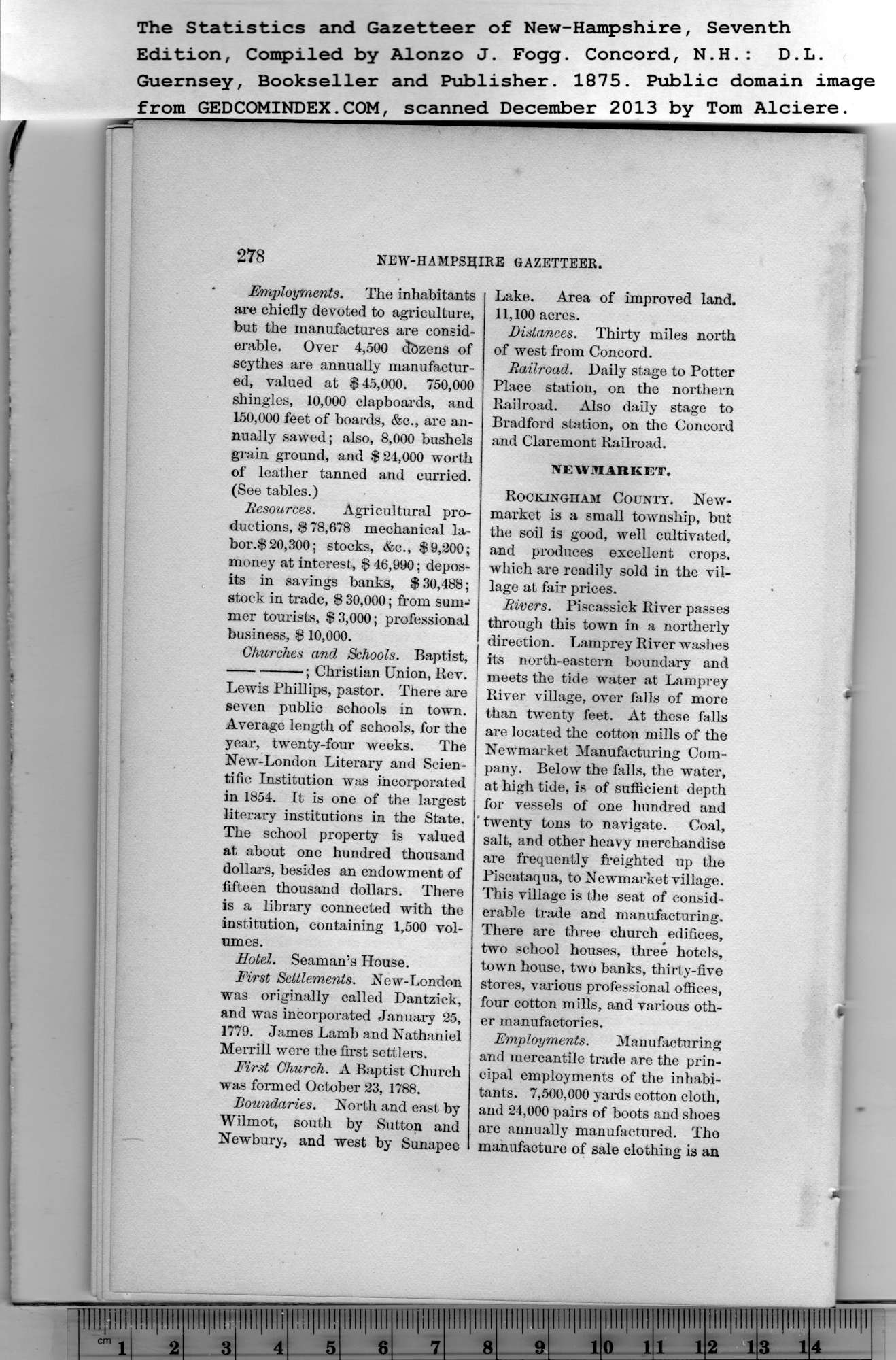|
278
The Statistics and Gazetteer of New-Hampshire, Seventh
Edition, Compiled by Alonzo J. Fogg. Concord, N.H.: D.L.
Employments. The inhabitants
are chiefly devoted to agriculture,
hut the manufactures are consid-
erable. Over 4,500 dbzens of
scythes are annually manufactur-
ed, valued at $45,000. 750,000
shingles, 10,000 clapboards, and
150,000 feet of boards, &c., are an-
nually sawed; also, 8,000 bushels
grain ground, and $24,000 worth
of leather tanned and curried.
(See tables.)
Resources. Agricultural pro-
ductions, $ 78,678 mechanical la-
bor^ 20,300; stocks, &c., $9,200;
money at interest, $ 46,990; depos-
its in savings banks, $30,488;
stock in trade, $ 30,000; from sum-
mer tourists, $3,000; professional
business, $ 10,000.
Churches and Schools. Baptist,
--; Christian Union, Rev.
Lewis Phillips, pastor. There are
seven public schools in town.
Average length of schools, for the
year, twenty-four weeks. The
New-London Literary and Scien-
tific Institution was incorporated
in 1854. It is one of the largest
literary institutions in the State.
The school property is valued
at about one hundred thousand
dollars, besides an endowment of
fifteen thousand dollars. There
is a library connected with the
institution, containing 1,500 vol-
umes.
Hotel. Seaman’s House.
First Settlements. New-London
was originally called Dantzick,
and was incorporated January 25,
1779. James Lamb and Nathaniel
Merrill were the first settlers.
First Church. A Baptist Church
was formed October 23, 1788.
Boundaries. North and east by
Wilmot, south by Sutton and
Newbury, and west by Sunapee |
Lake. Area of improved land.
11,100 acres.
Distances. Thirty miles north
of west from Concord.
Railroad. Daily stage to Potter
Place station, on the northern
Railroad. Also daily stage to
Bradford station, on the Concord
and Claremont Railroad.
NEWMARKET.
Rockingham County. New-
market is a small township, but
the soil is good, well cultivated,
and produces excellent crops,
which are readily sold in the vil-
lage at fair prices.
Rivers. Piscassick River passes
through this town in a northerly
direction. Lamprey River washes
its north-eastern boundary and
meets the tide water at Lamprey
River village, over falls of more
than twenty feet. At these falls
are located the cotton mills of the
Newmarket Manufacturing Com-
pany. Below the falls, the water,
at high tide, is of sufficient depth
for vessels of one hundred and
twenty tons to navigate. Coal,
salt, and other heavy merchandise
are frequently freighted up the
Piscataqua, to Newmarket village.
This village is the seat of consid-
erable trade and manufacturing.
There are three church edifices,
two school houses, three hotels,
town house, two hanks, thirty-five
stores, various professional offices,
four cotton mills, and various oth-
er manufactories.
Employments. Manufacturing
and mercantile trade are the prin-
cipal employments of the inhabi-
tants. 7,500,000 yards cotton cloth,
and 24,000 pairs of hoots and shoes
are annually manufactured. The
manufacture of sale clothing is an |
